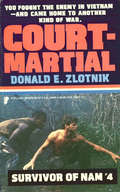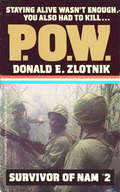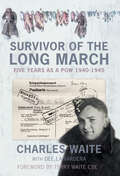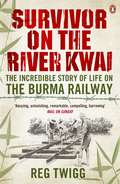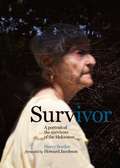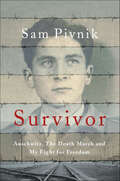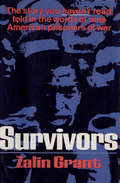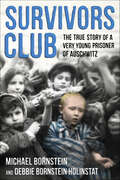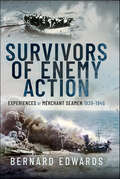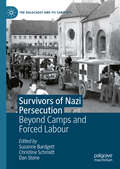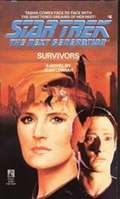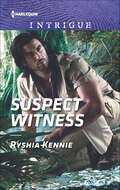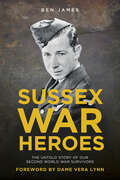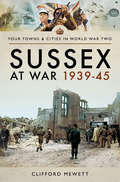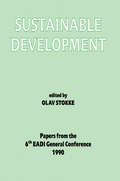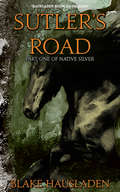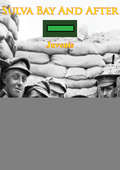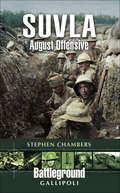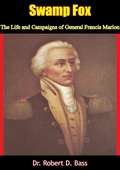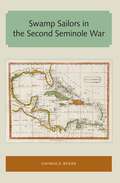- Table View
- List View
Survivor of Nam: Court Martial - Book #4 (Survivor of Nam #4)
by Donald E. ZlotnikYou fought the enemy in Vietnam--and came home to another kind of war. Book 4 of Survivor of Nam by Donald E. Zlotnik.
Survivor of Nam: P. O. W. (Survivor of Nam #2)
by Donald E. ZlotnikThe second exciting book in this authentic series about Vietnam involves a 17-year-old corporal who is imprisoned by the Viet Cong and must endure the horrors of his capture until the U.S. Special Forces can rescue him. A super-heroic series, focusing on the grim realities of war.
Survivor of the Long March: Five Years as a PoW 1940-1945
by Terry Waite Charles Waite Dee VarderaNothing prepares a man for war and Private Charles Waite, of the Queen’s Royal Regiment, was ill-prepared when his convoy took a wrong turning near Abbeville and met 400 German soldiers and half a dozen tanks. ‘The day I was captured, I had a rifle but no ammunition.’ He lost his freedom that day in May 1940 and didn’t regain it until April 1945 when he was rescued by Americans near Berlin, having walked 1,600 kms from East Prussia. Silent for seventy years, Charles writes about his five lost years: the terrible things he saw and suffered; his forced work in a stone quarry and on farms; his period in solitary confinement for sabotage; and his long journey home in one of the worst winters on record, across the frozen river Elbe, to Berlin and liberation. His story is also about friendship, of physical and mental resilience and of compassion for everyone who suffered. Part of that story includes the terrible Long March, or Black March, when 80,000 British POWs were forced to trek through a vicious winter westwards across Poland, Czechoslovakia and Germany as the Soviets approached. Thousands died. There are simply no memoirs of that terrible trek – except this one.
Survivor on the River Kwai: The Incredible Story of Life on the Burma Railway
by Reg TwiggSurvivor on the River Kwai is the heartbreaking story of Reg Twigg, one of the last men standing from a forgotten war. Called up in 1940, Reg expected to be fighting Germans. Instead, he found himself caught up in the worst military defeat in modern British history - the fall of Singapore to the Japanese.What followed were three years of hell, moving from one camp to another along the Kwai river, building the infamous Burma railway for the all-conquering Japanese Imperial Army. Some prisoners coped with the endless brutality of the code of Bushido by turning to God; others clung to whatever was left of the regimental structure. Reg made the deadly jungle, with its malaria, cholera, swollen rivers, lethal snakes and exhausting heat, work for him. With an ingenuity that is astonishing, he trapped and ate lizards, harvested pumpkins from the canteen rubbish heap and with his homemade razor became camp barber.That Reg survived is testimony to his own courage and determination, his will to beat the alien brutality of camp guards who had nothing but contempt for him and his fellow POWs. He was a risk taker whose survival strategies sometimes bordered on genius. Reg's story is unique.Reg Twigg was born at Wigston (Leicester) barracks on 16 December 1913. He was called up to the Leicestershire Regiment in 1940 but instead of fighting Hitler he was sent to the Far East, stationed at Singapore. When captured by the Japanese, he decided he would do everything to survive.After his repatriation from the Far East, Reg returned to Leicester. With his family he returned to Thailand in 2006, and revisited the sites of the POW camps. Reg died in 2013, at the age of ninety-nine, two weeks before the publication of this book.
Survivor: A portrait of the survivors of the Holocaust
by Harry Borden'A masterpiece and deeply moving' - Alain de Botton'A wonderful piece of work' - Lynn Barber"...something really to behold, a substantial project of some real depth and authority. By flicking through the pages you can sense the amount of research, patience and hard work that has been invested. The portraits, as always with Borden are simple, effective and very telling." - Martin ParrSurvivor is a unique and powerful testimony of what it is to live with memories of the Holocaust.Over the course of five years, acclaimed photographer Harry Borden has travelled the globe photographing survivors of the Holocaust. The people featured vary in age, gender and nationality, but are all tied together by their experience and survival of one of the darkest moments in human history.Each photograph is accompanied by a handwritten note from the sitter, ranging from poems, to memories, to hopes for the future, creating a strong sense of intimacy between sitter and reader. At the end of the book is a section providing more information about the person in each portrait, and about how and what they survived, together with the historical context of the events they lived through. Thought-provoking and touching, this book conveys the dignity and humanity of each subject's character.
Survivor: Auschwitz, The Death March And My Fight For Freedom
by Sam Pivnik**For fans of The Tattooist of Auschwitz**Sam Pivnik is the ultimate survivor from a world that no longer exists. On fourteen occasions he should have been killed, but luck, his physical strength and his determination not to die all played a part in Sam Pivnik living to tell his extraordinary life story. In 1939, on his thirteenth birthday, his life changed forever when the Nazis invaded Poland. He survived the two ghettoes set up in his home town of Bedzin and six months on Auschwitz's notorious Rampkommando where prisoners were either taken away for entry to the camp or gassing. After this harrowing experience he was sent to work at the brutal Furstengrube mining camp. He could have died on the 'Death March' that took him west as the Third Reich collapsed and he was one of only a handful of people who swam to safety when the Royal Air Force sank the prison ship Cap Arcona, in 1945, mistakenly believing it to be carrying fleeing members of the SS. He eventually made his way to London where he found people too preoccupied with their own wartime experiences on the Home Front to be interested in what had happened to him. Now in his eighties, Sam Pivnik tells for the first time the story of his life, a true tale of survival against the most extraordinary odds.
Survivor: Auschwitz, The Death March And My Fight For Freedom (Extraordinary Lives, Extraordinary Stories of World War Two #4)
by Sam Pivnik**For fans of The Tattooist of Auschwitz**Sam Pivnik is the ultimate survivor from a world that no longer exists. On fourteen occasions he should have been killed, but luck, his physical strength and his determination not to die all played a part in Sam Pivnik living to tell his extraordinary life story. In 1939, on his thirteenth birthday, his life changed forever when the Nazis invaded Poland. He survived the two ghettoes set up in his home town of Bedzin and six months on Auschwitz's notorious Rampkommando where prisoners were either taken away for entry to the camp or gassing. After this harrowing experience he was sent to work at the brutal Furstengrube mining camp. He could have died on the 'Death March' that took him west as the Third Reich collapsed and he was one of only a handful of people who swam to safety when the Royal Air Force sank the prison ship Cap Arcona, in 1945, mistakenly believing it to be carrying fleeing members of the SS. He eventually made his way to London where he found people too preoccupied with their own wartime experiences on the Home Front to be interested in what had happened to him. Now in his eighties, Sam Pivnik tells for the first time the story of his life, a true tale of survival against the most extraordinary odds.
Survivor: Auschwitz, The Death March and My Fight for Freedom
by Sam Pivnik“[A] deeply intimate account . . . Masterfully conveys the grim absurdity of the Nazi mentality and the utter dejection of the concentration-camp prisoner.” —Kirkus ReviewsSam Pivnik is the ultimate survivor from a world that no longer exists. On fourteen occasions he should have been killed, but luck, his physical strength, and his determination not to die all played a part in Sam Pivnik living to tell his extraordinary story.In 1939, on his thirteenth birthday, Pivnik’s life changed forever when the Nazis invaded Poland. He survived the two ghettoes set up in his home town of Bedzin and six months on Auschwitz’s notorious Rampe Kommando where prisoners were either taken away for entry to the camp or gassing. After this harrowing experience he was sent to work at the brutal Fürstengrube mining camp. He could have died on the ‘Death March’ that took him west as the Third Reich collapsed and he was one of only a handful of people who swam to safety when the Royal Air Force sank the prison ship Cap Arcona in 1945, mistakenly believing it to be carrying fleeing members of the SS.He eventually made his way to London where he found people too preoccupied with their own wartime experiences on the Home Front to be interested in what had happened to him.Now in his eighties, Sam Pivnik tells for the first time the story of his life, a true tale of survival against the most extraordinary odds.“Absorbing and often riveting . . . another worthy addition to the books on the horrors of Nazi occupation.” —Booklist
Survivors
by Zalin Grant<P> This book may well be the most unusual document to come out of the Viet Nam war. It is the moving story of nine American soldiers and pilots who were captured and held prisoner for five years. It could only be told in their own words; and so the author interviewed each of the nine men, and edited and wove their accounts together to form a single, compelling narrative of war and survival. <P> For three years these Americans were held in a Viet Cong jungle prison, where they struggled against starvation- and themselves. They describe the details of their daily existence as the war ebbed and flowed around them: the rats, the terror of American bombing raids, the sickness. Through juxtaposition of their individual stories we see the subtle, destructive tensions that operate on a group of men in such desperate circumstances. Then they marched up the Ho Chi Minh trail to Hanoi, where their physical ordeal gave way to an agonizing moral dilemma. Should they join the "Peace Committee", a group of POW's protesting the war? Or should they resist their captors by all possible means as ordered by the secret American commander of the Hanoi prison? After three years in the jungle on the edge of survival, each man had to answer the questions: Who am I? What do I believe? <P> These nine men form a cross section of the army we sent to Viet Nam. Their words illuminate not only their individual background and experience, but also the meaning of the war for us all.
Survivors Club: The True Story of a Very Young Prisoner of Auschwitz
by Michael Bornstein Debbie Bornstein HolinstatA New York Times bestseller“Both moving and memorable, combining the emotional resolve of a memoir with the rhythm of a novel.” —New York Times Book ReviewIn 1945, in a now-famous piece of World War II archival footage, four-year-old Michael Bornstein was filmed by Soviet soldiers as he was carried out of Auschwitz in his grandmother’s arms. Survivors Club tells the unforgettable story of how a father’s courageous wit, a mother’s fierce love, and one perfectly timed illness saved his life, and how others in his family from Zarki, Poland, dodged death at the hands of the Nazis time and again with incredible deftness. Working from his own recollections as well as extensive interviews with relatives and survivors who knew the family, Michael relates his inspirational Holocaust survival story with the help of his daughter, Debbie Bornstein Holinstat. Shocking, heartbreaking, and ultimately uplifting, this narrative nonfiction offers an indelible depiction of what happened to one Polish village in the wake of the German invasion in 1939.This thoroughly-researched and documented book can be worked into multiple aspects of the common core curriculum.A New York City Public Library Notable Best Book for Teens
Survivors of Enemy Action: Experiences of Merchant Seamen, 1939–1945
by Bernard EdwardsThe war years 1939 – 1945 were the most perilous in the long history of the British Merchant Navy. The figures speak for themselves. With 2,535 ships sunk and 36,749 merchant seamen lost, the proportional casualty rate was higher than any branch of the Armed Forces except for Bomber Command. The danger to the lightly armed merchant ships came from enemy air attacks, surface warships, raiders and, of course submarines. Prisoners were seldom taken so the crews of stricken vessels had to fend for themselves. Those who survived enemy action faced death by drowning, exposure and lack of food and water. Compiled mainly from experiences related direct to the author, this inspiring book draws on first-hand accounts of the lucky few who survived. With extraordinary honesty and modesty their stories describe the events leading up to the enemy attack, the actions and the aftermath. Readers will be struck by the courage and fortitude of these men who often suffered extreme hardship and privation. Too many died before reaching land or being rescued. These men are without doubt the unsung heroes of the Second World War and this fine book is an overdue recognition of their sacrifices and courage.
Survivors of Nazi Persecution: Beyond Camps and Forced Labour (The Holocaust and its Contexts)
by Christine Schmidt Dan Stone Suzanne BardgettThis volume contains thirteen selected papers from the seventh international 'Beyond Camps and Forced Labour conference', held in London in January 2023. The geographical and methodological scope of the chapters, ranging from postwar trials to survivors’ memoirs and former classmates’ letters, from Greece to the Soviet Union, France to Croatia, indicates both the range encompassed by Holocaust Studies’ focus on the immediate postwar period and the expansion and flourishing of the discipline. The book examines the experiences of forced labourers, postwar struggles to obtain restitution for stolen property, the political and cultural activities of displaced persons, trials of perpetrators, and the emergence of survivors’ collective memory. With chapters on non-Jewish forced labourers, Roma and the care of Black youngsters by a noted Jewish refugee, the book speaks to the international dimensions of the Holocaust and its effects, and shows how postwar responses to the Nazi crimes shaped the world after 1945. The vast range of groups affected by the Nazis’ crimes found its echo in the postwar responses of many different constituencies, and this volume highlights, on the basis of cutting-edge historical research, why the turn to the aftermath of World War II and the Holocaust is so important a part of Holocaust Studies.
Survivors: True Tales Of Endurance (Star Trek: The Next Generation #4)
by Jean LorrahTreva is an isolated human colony on the fringes of known space on the verge of becoming a true interstellar community, a full fledged menber of the Federation. But now the U.S.S. EnterpriseTM has received a distress signal for Treva is in the throes of a violent revolution, a revolution led by a merciless warlord who has committed countless atrocities in the name of freedom. Data and Lt. Tasha Yar are dispatched to investigate. Once they reach Treva, they discover the truth, and any possible solution may be far more complex than a simple rebellion. Treva's president wants more then Starfleet's good words in her fight against the rebels, she wants their weapons technology. And before the battle is over, she means to get them. Over Data's and Yar's dead bodies, if necessary.
Suspect Witness
by Ryshia KennieAn undercover operation is the only way to bring an innocent witness home... After months searching for a schoolteacher on the run from a criminal gang, CIA operative Josh Sedovich finally finds the innocent beauty in the remotest part of Malaysia. Eager to get Erin Argon home and into protective custody, Josh goes undercover to gain her trust and prove he isn't a threat. And although Erin claims to have witnessed the murder of a very dangerous man, Josh knows there's more to the story than she's letting on. But getting to know Erin-in public and behind closed doors-makes Josh realize just how determined she is to keep the truth hidden. Seems he isn't the only one keeping secrets that could get them both killed...
Suspicious Activity: A Legal Thriller
by Mike Papantonio Christopher PaulosSuspicious Activity is an epic drama of intrigue, suspense, thrills, and legal combat—torn out of today&’s headlines. &“The purpose of the lawsuit is to fully expose the bank&’s willing support to groups that are killing Americans—and others—overseas.&” This announcement by attorney Nicholas &“Deke&” Deketomis sets up the gladiatorial arena between Big Banking and a team of well-meaning activist lawyers. The Iraq and Afghanistan Wars introduced the concept of IEDs (Improvised Explosive Devices) and EFPs (Explosively Formed Penetrators) that seriously maim or kill. It appears that these bombs are still being made and utilized by terrorists overseas. Who is funding them? Could it possibly be a large global bank with a major branch in New York? Is a reverse money laundering scheme in place that allows money transactions to bypass Department of Justice sanctions? Deke and his colleagues—co-counsel Michael Carey and investigators Carol Morris and Jake Rutledge—set out to uncover the deceit and bring the white collar criminals to justice. With the help of Michael&’s friend and war veteran, Joel Hartbeck—who first blows the whistle against the bank—the Deketomis team quickly discovers that they may have tackled more than they bargained for. A dangerous right wing paramilitary group might be involved in protecting the bank&’s interests, and Hartbeck soon goes missing. As Deke&’s lawsuit progresses, the sudden appearance of IEDs and EFPs on US highways cause death and destruction. Who is behind this evil?Readers who devour the financial-action-legal thrillers of Joseph Finder, Stephen Frey, and James Grippando will enjoy Suspicious Activity.
Sussex War Heroes: The Untold Story of our Second World War Survivors
by Ben JamesA generation of ordinary young men and women were thrust into the most extraordinary of situations when the Second World War was declared. Sussex is full of war heroes, but soon they will be gone – along with their stories.This is not a book about Victoria Cross winners or the celebrities of days gone by, but the untold accounts of everyday heroes who ‘did their bit’. It is about former train engineer Bob Morrell, who was beaten, starved and tortured in the brutal Japanese prisoner camps. It is about ex-pub landlord John Akehurst, who gave the Germans the run-around Northern Europe after being shot down. And it is about Shindy Perez and her remarkable escape from the gas chambers of Auschwitz.As this important period passes from living memory into history, this is likely to be the last time that these personal tales are told, tales which should never be forgotten.
Sussex at War, 1939–45
by Clifford MewettFrom the Dunkirk evacuation, Sussex became a front-line County and a likely invasion area if the German's launched their feared attack.This book takes an in depth look at the fortification of the County, the plight of the evacuees who were hurriedly moved from London to escape the threat of the capital being bombed and who were re-evacuated when German air attacks caused much damage and loss of life. The Luftwaffe's tip and run raids were particularly feared.Many thousands of Canadian troops were stationed in Sussex, from where they launched the disastrous raid on Dieppe. Sussex was also heavily involved in the build up to D Day and suffering badly from the much feared Doodlebugs, Hitler's revenge weapon.When victory was secured in 1945 Sussex celebrated as Prisoners of War came home and soldiers, sailors and airmen were demobbed.Sussex at War 1939–1945 also looks at the role played by the civilian population, voluntary organisations and the spirit of defiance which swept the County.If you are interested in wartime Sussex history, local history of the second world war or Britain's war effort and life on the home front, then this is the book for you.
Sustainable Development
by Olav StokkeFirst published in 1991. Routledge is an imprint of Taylor & Francis, an informa company.
Sustaining Key Skills in the UK Military Aircraft Industry
by Tony Starkey Nigel Edgington Hans Pung Matt Bassford Kristin WeedThe United Kingdom Ministry of Defence's Fixed Wing Sector Strategy Board commissioned RAND Europe to assist in the development of a strategy and sustainment plan for the military fixed wing sector. RAND focused on the health and sustainment of key skills in the sector's industrial base. This monograph describes the qualitative and quantitative methodologies that the RAND team followed and summarises its findings and recommendations.
Sustaining U.S. Nuclear Submarine Design Capabilities
by Jessie Riposo Paul Deluca John F. Schank Mark V. Arena Kimberly Curry HallNuclear submarine design resources at the shipyards, their suppliers, and the Navy may erode for lack of demand. Analysis of alternative workforce and workload management options suggests that the U.S. Navy should stretch out the design of the next submarine class and start it early or sustain design resources above the current demand, so that the next class may be designed on time, on budget, and with low risk.
Sutler's Road (Native Silver #1)
by Blake Hausladen“If you enjoy epic fantasy, particularly epic fantasy in which the world building is superb, do yourself a favor and grab Ghost in the Yew and Native Silver.” – Stephen, GoodreadsThis novella is part one of Native Silver, also available as a collection.You can read the trilogy in full volumes, or broken up into five novellas each.The Vestal Series1. Ghosts in the Yew Novella 1 - Beyond the Edge Novella 2 - Opposing Oaths Novella 3 - Reckless Borders Novella 4 - Bayen's Women Novella 5 - Falling Tides2. Native Silver Novella 1 - Sutler's Road Novella 2 - Forgotten Stairs Novella 3 - Thrall's Wine Novella 4 - Corsair Princess Novella 5 - Tanayon Born 3. The Vastness Novella 1 - Silent Rebellion Novella 2 - The River War Novella 3 - The Blinded Novella 4 - Crimson Valley Novella 5 - Singer's Reward“Rich and wonderful characters drive this epic tale.” – Matthew, Goodreads
Suvla Bay And After [Illustrated Edition]
by JuvenisIncludes Gallipoli Campaign Map and Illustrations Pack -71 photos and 31 maps of the campaign spanning the entire period of hostilities.A moving and wittily written account of an officer of the 5th Royal Inniskilling Fusiliers of the 10 (Irish Division) during their heroic but futile campaign on the Gallipoli Peninsula. He landed with his men of 'D' company into the storm of shot, shell and death at Suvla Bay and fought hard against the elements and the Turks. He was wounded in August 1915 and evacuated to Lemnos and thence back to England, where he wrote his recollections during his convalescence. As acclaimed expert Cyril Falls wrote of Juvenis' "...book is far ahead of the majority of disjointed accounts of warfare which appeared in those in those early days and has literary merit."
Suvla: August Offensive (Battleground Gallipoli)
by Stephen ChambersThe landing at Suvla Bay, part of the August Offensive, commenced on the night of 6 August 1915. It was intended to support a breakout from Anzac Beach. Despite early hopes from a largely unopposed landing, Suvla was a mismanaged affair that quickly became a stalemate. The newly formed IX Corps, commanded by Lieutenant General Sir Frederick Stopford, failed, not for lack of sacrifice by its New Army and Territorials, but because of a failure of generalship. Opportunities were thoughtlessly wasted due to lethargy. Suvla not only signaled the end of Stopford and many of his Brigadiers, but also saw the end of the Commander in Chief, Sir Ian Hamilton. It was the beginning of the end of the Gallipoli gamble and in its own right created a catalyst of disaster that would come to represent the failed campaign.This book adds to the Gallipoli story by recounting the Suvla Bay landing through a mix of official accounts intertwined with a rich collection of the participants letters, diaries, personal accounts, photographs and maps.
Swamp Fox: The Life and Campaigns of General Francis Marion
by Dr Robert D. BassOne of the most fascinating figures of the American Revolution, General Francis Marion slipped in and out of the Carolina swamps to strike sudden, devastating blows against the British. Cutting through the Swamp Fox legend, Robert D. Bass has arrived at a realistic and fascinating appraisal of this military genius with this 1959 literary work.“[A] close but spirited chronology of the raids and routs [General Francis Marion] led against the British. A humane man, a dedicated soldier with a devotion to duty and a worship of liberty, [he] was also a taciturn, moody and introverted character. With an intuitive sense of strategy, particularly that of the swift advance and the rapid retreat, he became a sound and savage fighter […] rose from the ranks as an unknown captain to become a Brigadier General. Here, bivouac by bivouac, are the lashes and the sieges in which he engaged; the daring rescue of 150 Rebel prisoners from Sumter’s house; the bedevilment and the destruction of the British is small diversionary actions; and the indefatigable endurance of that gaunt, ill-kempt, gallant fighter who became a nemesis to Cornwallis and the entire British Army....”—Kirkus Review
Swamp Sailors in the Second Seminole War (Florida and the Caribbean Open Books Series)
by George E. BukerThe books in the Florida and the Caribbean Open Books Series demonstrate the University Press of Florida’s long history of publishing Latin American and Caribbean studies titles that connect in and through Florida, highlighting the connections between the Sunshine State and its neighboring islands. Books in this series show how early explorers found and settled Florida and the Caribbean. They tell the tales of early pioneers, both foreign and domestic. They examine topics critical to the area such as travel, migration, economic opportunity, and tourism. They look at the growth of Florida and the Caribbean and the attendant pressures on the environment, culture, urban development, and the movement of peoples, both forced and voluntary.The Florida and the Caribbean Open Books Series gathers the rich data available in these architectural, archaeological, cultural, and historical works, as well as the travelogues and naturalists’ sketches of the area prior to the twentieth century, making it accessible for scholars and the general public alike.The Florida and the Caribbean Open Books Series is made possible through a grant from the National Endowment for the Humanities and the Andrew W. Mellon Foundation, under the Humanities Open Books program.
